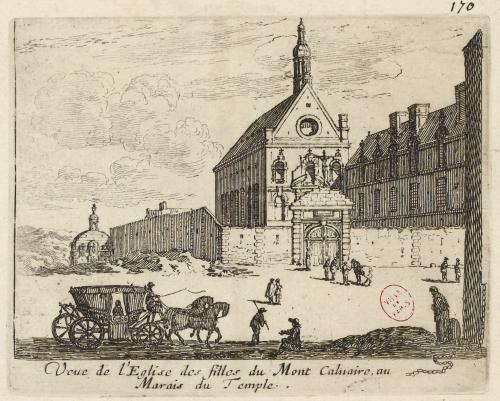Notre-Dame Du Calvaire, Paris on:
[Wikipedia]
[Google]
[Amazon]

 The Convent of Our Lady of Calvary (), also named Convent of the ''Filles du Calvaire'' (), is a former
The Convent of Our Lady of Calvary (), also named Convent of the ''Filles du Calvaire'' (), is a former

 The Convent of Our Lady of Calvary (), also named Convent of the ''Filles du Calvaire'' (), is a former
The Convent of Our Lady of Calvary (), also named Convent of the ''Filles du Calvaire'' (), is a former Roman Catholic
The Catholic Church (), also known as the Roman Catholic Church, is the largest Christian church, with 1.27 to 1.41 billion baptized Catholics worldwide as of 2025. It is among the world's oldest and largest international institut ...
convent
A convent is an enclosed community of monks, nuns, friars or religious sisters. Alternatively, ''convent'' means the building used by the community.
The term is particularly used in the Catholic Church, Lutheran churches, and the Anglican ...
in Paris
Paris () is the Capital city, capital and List of communes in France with over 20,000 inhabitants, largest city of France. With an estimated population of 2,048,472 residents in January 2025 in an area of more than , Paris is the List of ci ...
, France
France, officially the French Republic, is a country located primarily in Western Europe. Overseas France, Its overseas regions and territories include French Guiana in South America, Saint Pierre and Miquelon in the Atlantic Ocean#North Atlan ...
.
Location
The convent was located between streets , Rue Boucherat (now ), and .History
Father Joseph purchased the ''Hôtel de l'Ardoise'', a property located at the end of , in order to fund a second establishment for the Nuns of Our Lady of Calvary. The nuns settled in the building in 1633. The foundation stone of the church was laid in 1635 by Dutchess d'Aiguillon, who was standing in for her uncleCardinal Richelieu
Armand Jean du Plessis, 1st Duke of Richelieu (9 September 1585 – 4 December 1642), commonly known as Cardinal Richelieu, was a Catholic Church in France, French Catholic prelate and statesman who had an outsized influence in civil and religi ...
.
The convent, completed on April 10, 1637, was supposed to be named the "Convent of the Crucifixion
Crucifixion is a method of capital punishment in which the condemned is tied or nailed to a large wooden cross, beam or stake and left to hang until eventual death. It was used as a punishment by the Achaemenid Empire, Persians, Ancient Carthag ...
" as requested by Father Joseph, but the church was consecrated in 1650 as the "Church of the Transfiguration". In the same period, the nuns of Our Lady took possession of the church.
The Congregation of Our Lady of Calvary was dissolved in 1790 during the French Revolution, and their property was sold as a national good on ''Vendémiaire
Vendémiaire () was the first month in the French Republican calendar. The month was named after the Occitan word ''vendemiaire'' 'grape harvester'.
Vendémiaire was the first month of the autumn quarter (''mois d'automne''). It started on the d ...
'' 8, Year V (September 29, 1796). In 1804, the Rue Neuve-de-Bretagne (now ) and Rue Neuve-de-Ménilmontant (now ), were established through the site of the former convent, without any permission. They were incorporated into the public road system in 1806. A third street and a passageway, which were planned as a part of the housing estate plan on the site, were not established.
References
Bibliography
* Napoléon Chaix, ''Paris guide, 1807'' , Librairie internationale. *Jacques Hillairet
Auguste André Coussillan (31 July 1886 – 15 April 1984) was a French historian specialising in the history of Paris. Under the pen-name Jacques Hillairet he wrote two major reference works on the subject in the 1950s - ''Connaissance du vieux ...
, ''Dictionnaire historique des rues de Paris
''Dictionnaire historique des rues de Paris'' (''Historical Dictionary of the Streets of Paris'') is a book by Jacques Hillairet, a historian specializing in the history of Paris. It includes 5344 streets in two volumes and 2343 illustrations. It ...
'' .
* Félix et Louis Lazare, ''Dictionnaire administratif et historique des rues de Paris et de ses monuments
The ''Dictionnaire administratif et historique des rues de Paris et de ses monuments'' 'Administrative and Historical Dictionary of the Streets and Monuments of Paris''is a dictionary of the public streets, monuments and buildings of Paris
...
'' , 1844.
* Jean de La Tynna, ''Dictionnaire topographique, étymologique et historique des rues de Paris'' {{in lang, fr, 1817.
Convents in Paris
Former buildings and structures in Paris
1630s establishments in France
Destroyed churches in France
Roman Catholic churches in the 3rd arrondissement of Paris